By Joseph D’Aleo, CCM, AMS Fellow
There are signs our weather is taking a time machine ride back to the regimes of the 1960s or even the late 1700s early 1800s. Our climate operates in cycles, which favors different regimes of weather. We have come out of a few decades that thanks to a warm Pacific resulted in a dominance of El Ninos and its typical southern storm tracks and warm, dry western North America.
The Pacific has cooled and now favors La Ninas, which have dominated the last two winters. This has resulted in a more northern storm track (and as we reported in earlier stories (here and here and here), record monthly or seasonal snows).
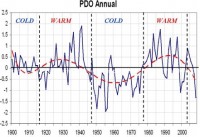
See larger image here.

See larger image here.
See how cold PDOs of the 1947 to 1977 led to mainly La Ninas
The Atlantic is cooling too. The AMO has declined from its 2004/05 peak. The sum of the PDO and AMO (normalized) we have shown correlates well with US annual temperatures.
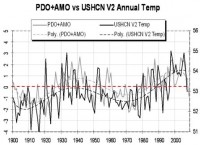
See larger image here.
In earlier reports, we have shown how the solar cycles also have a profound affect on climate (for example here and here). An active sun through direct and indirect factors leads to warming oceans and through them the land, and a quiet sun to cooling of oceans and land.
In the last century, we are with the cooling of the oceans, and a quiet sun most like the 1960s (graph below), a cold era as shown in the graph above.
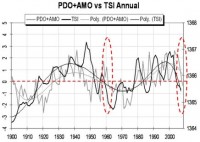
See larger image here.
See how well the temperatures match with the solar and ocean cycles.
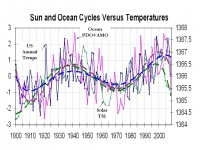
See larger image here.
Longer term the sun is behaving like it did in the last 1700s and early 1800s, leading many to believe we are likely to experience conditions more like the early 1800s (called the Dalton Minimum) in the next few decades. That was a time of cold and snow. It was the time of Charles Dickens and his novels with snow and cold in London (hmmmm).
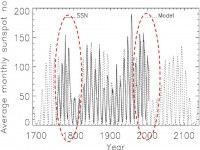
See larger image here.
During these cold modes, more La Nina winters like this occur, El Ninos occasionally develop, tend to be briefer and weaker and thus colder and snowier than the El Ninos of the warm eras. If a major volcano occurs, the cold deepens. See the complete story as posted on Intellicast here.
New Maine and New England All-Time Cold Record ConfirmedBy Giselle Goodman, Maine Portland Press Herald - Maine Today
The National Oceanic and Atmospheric Administration, U.S. Geological Survey and Maine State Climate Office announced today that a minus-50 reading in northwestern Maine held up to scientific scrutiny. That beats Maine’s old record of 48 below zero set in 1925 in Van Buren, and ties the record for coldest temperature recorded in New England. That reading was made in 1933 in Bloomfield, Vt.
The record on New Hampshire’s Mount Washington is minus -47. Maine’s minus-50 reading was made on Jan. 16 at a remote site along the Big Black River near the Quebec border as the region was in the grip of a blast of arctic air.
By the way after a thaw this week, cold air will return starting Friday to the nation. Watch for lots of cold and snow probably the rest of the month.
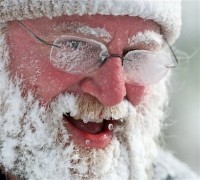
See story here. Don’t expect it to receive a lot of national media coverage.
Peerless Refutation of Scientifically Unjustifiable Scaremongering about “Global Warming”By Christopher Monckton, SPPI
We reproduce, paragraph by paragraph, a typical scaremongering article about “global warming” that was published in The Guardian in London on 9 February 2008. In bold face, we show, paragraph by paragraph, how easy it would be for a correctly-informed and unprejudiced journalist to write a true story that reached accurate conclusions diametrically opposite to those of The Guardian.
Scientists are to hold an emergency summit to warn the world’s politicians they are being too timid in their response to global warming, said David Adam, the environment correspondent of The Guardian, in early February 2009.
Scientists, statesmen, and researchers into climate change will be meeting in New York in early March 2008 to warn the world’s politicians that they are spending far too much taxpayers’ money addressing the non-problem of “global warming”. Global temperatures have been on a falling trend throughout the eight years of the Bush presidency, said Christopher Monckton of Brenchley, a British peer, in early February 2009.
Climate experts from across the world will gather in Copenhagen next month to agree a stark message to policy makers, which they hope will break the political deadlock on efforts to curb rising temperatures. The meeting follows “disturbing” studies that suggest global warming could strike harder and faster than expected.
Climate experts from across the world will gather in New York next month to agree a stark message to policy makers, which they hope will alert politicians to the absurdity of trying to curb rising temperatures, particularly since temperatures this millennium have not been rising but falling. The meeting follows “heartening” studies that suggest “global warming” is nonsense and will have far less effect than expected.
It comes ahead of a year of high-level political discussions on climate change, which climax with international negotiations in Copenhagen in December, where officials will try to hammer out a successor to the Kyoto protocol.
It comes ahead of a year of high-level politicians gradually coming to realize that “global warming” is a scientific fraud. Vaclav Klaus, president of the Czech Republic and currently also president of the world’s largest trading bloc, the European Union, is one of a growing band of politicians unwilling to allow taxpayers to be further defrauded. There is no need for a successor to the Kyoto Protocol, which the US Senate under Al Gore rejected by 95 votes to 0, and which nearly all signatories have dishonored by non-compliance.
Katherine Richardson, a marine biologist at the University of Copenhagen, who is organising next month’s event, said: “This is not a regular scientific conference. This is a deliberate attempt to influence policy.”
Christopher Monckton, an investigator of scientific frauds, who is topping the bill as the valedictorian keynote speaker at the New York climate conference, said: “Global warming is not a regular scientific topic. This is a deliberate fraud intended to influence policy.”
The meeting will publish an update to the 2007 report of the Intergovernmental Panel on Climate Change (IPCC). Richardson said the IPCC report was “wishy-washy” on issues such as sea level rise. “The IPCC talks of a 40cm sea rise this century. Well, if the consensus now is a rise of a
metre or more then they need to know that.”
The New York meeting will publish an update to the 2008 Manhattan Declaration calling upon politicians not to waste time or taxpayer dollars on the climate chimera, or on issues such as sea level rise. The IPCC had projected that sea level would rise 3 feet by 2100, but in 2007, faced with overwhelming evidence from realworld data and from peer-reviewed scientific papers that sea level is rising at little more than 1 ft per century and will not rise very much faster than that, has recently cut its high-end projection to less than 2 feet per century.
A number of studies published since the IPCC report was prepared show that carbon emissions are rising faster than expected and that existing greenhouse gas targets may not be enough to prevent catastrophic temperature rise. Climate experts, including Jim Hansen, of NASA, have warned
about so-called “tipping points” that could lead to runaway warming and rapid sea level rise.
A number of studies published since the IPCC report was prepared show that carbon dioxide concentrations are rising at well below the IPCC’s lowest estimate and that even without existing greenhouse gas targets there is no chance of catastrophic temperature rise. Climate experts, including the late Edward Lorenz, have warned that so-called “tipping-points” that could lead to runaway warming and sea-level rise cannot be predicted “by any method”.
Read full refutation PDF here. See SPPI’s new Monthly CO2 Report here.
By Lord Monckton
The scare: An article published in early February 2009 by Jonathan Leake, the environment editor of The Times of London, said “The ice caps are melting so fast that the world’s oceans are rising more than twice as fast as they were in the 1970s.” The Times said that “scientists” had used satellites “to track how the oceans are responding as billions of gallons of water reach them from melting ice sheets and glaciers”, an effect “compounded by thermal expansion”.
The article said that in the past 15 years “sea levels have been rising at 3.4mm a year, much faster than the average 1.7mm recorded by tidal gauges over the past 50 years.” A scientist was quoted as saying, “This rate, observed since the early 1990s, could reflect an acceleration linked to global warming.” The article added that figures from the UK Meteorological Office suggested that sea level in the tidal reaches of the River Thames could rise by as much as 6ft 6in by 2100.
The truth: First, there is nothing new in this article. Ever since the TOPEX/JASON sea-level monitoring satellites began transmitting data in 1993, they have shown sea level as rising at a near-linear rate equivalent to 1 ft/century, compared with the 8 in/century previously estimated for the 20th century by the use of tide-gages. However, it is thought likely that the apparent increase in the rate of sea-level rise is chiefly an artefact of the change in mensuration from tide-gages to satellites in 1993.
Furthermore, in response to the very sharp global cooling of the last few years, the rate of increase in sea level appears to have slowed somewhat, though it is not yet clear whether the trend will continue, and no data from the JASON satellite has been published since the late summer of 2008.
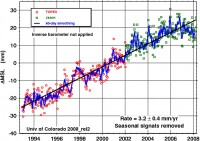
In 2007 the UN reduced its high-end estimate of sea-level rise from 3 ft to less than 2 ft over the 21st century. The mean rate of sea-level rise over the past 10,000 years has been 4 ft/ century, though The Times was very careful not to provide this perspective in its article.
There is little scientific basis for the article’s assertion that “the ice-caps are melting fast”. There has been some decline in sea-ice extent in the Arctic, but this decline is well within natural climate variability and cannot be attributed to anthropogenic “global warming”, because the mere fact of warming (which, in any event, has not occurred for 13 years) tells us nothing of the cause of the warming.
In the Antarctic, however, sea-ice extent has recently reached a record high, and the current accumulation of land-ice at the South Pole is 8850 feet deep, increasing annually. The Times somehow failed to mention the Antarctic in its article.
For most of the past 10,000 years - most recently in the Roman and medieval warm periods - temperatures were up to 3 Celsius degrees (5.5 Fahrenheit degrees) warmer than the present. Each of the past four interglacial periods was up to 6 Celsius degrees (11 Fahrenheit degrees) warmer than the present. Humankind cannot have been to blame. End of scare.
Also note as CO2Science reported here: “Holgate (2007) calculated that the mean rate of global sea level rise was “larger in the early part of the last century (2.03 plus or minus 0.35 mm/yr 1904-1953), in comparison with the latter part (1.45 plus or minus 0.34 mm/yr 1954-2003).”
Another Dalton Minimum Possible!By C. de Jager, S. Duhau in paper ”Forecasting the parameters of sunspot cycle 24 and beyond.”, Journal of Atmospheric and Solar-Terrestrial Physics, vol. 71 (2009), pages 239 – 245
Abstract: Solar variability is controlled by the internal dynamo which is a nonlinear system. We develop a physical-statistical method for forecasting solar activity that takes into account the non-linear character of the solar dynamo. The method is based on the generally accepted mechanisms of the dynamo and on recently found systematic properties of the long-term solar variability. The amplitude modulation of the Schwabe cycle in the dynamo’s magnetic field components can be decomposed in an invariant transition level and three types of oscillations around it. The regularities that we observe in the behaviour of these oscillations during the last millennium enable us to forecast solar activity. We find that the system is presently undergoing a transition from the recent Grand Maximum to another regime.
This transition started in 2000 and it is expected to end around the maximum of cycle 24, foreseen for 2014, with a maximum sunspot number Rmax = 68 plus/minus 17. At that time a period of lower solar activity will start. That period will be one of regular oscillations, as occurred between 1730 and 1923. The first of these oscillations may even turn out to be as strongly negative as around 1810, in which case a short Grand Minimum similar to the Dalton one might develop. This moderate to low-activity episode is expected to last for at least one Gleissberg cycle (60 - 100 years). See full paper PDF here.
Notice the similarities of the last four cycles in terms of cycle length to the first four in the 1700s to early 1800s prior to the Dalton Minimum. Length of cycle 23 still not determined but will be at least 12.4 years.
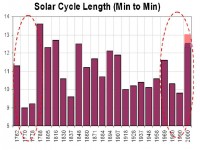
See larger here
Notice the similarity to Clilverd’s (2007) statistically based cycle forecasts.

See larger here
By Mike Dubrasich, Western Institute for the Study of the Environment (WISE)
The latest issue of Nature boasts the cover story: Antarctic Warming. The problem is that the research paper being touted is based on bad data.
Statistician, global warming skeptic, and blogger Steve McIntyre of Climate Audit [here] has discovered that the Antarctic weather station data—upon which the paper in Nature was based—was tainted. Temperature data from two different stations, “Harry” and “Gill” in West Antarctica were combined to produce an erroneous uptick in historical readings.
In addition, meteorologist, weather station guru, and blogger Anthony Watts of Watts Up With That has demonstrated that numerous Antarctic weather stations may have serious data problems. Snow has piled up around temperature sensors—effectively insulating the temperature monitoring stations from the bitterly cold extremes of the southern-most continent [here ].
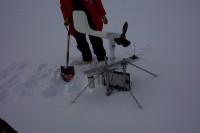
A University of Washington Press Release dated January 21, 2009, hailed new findings of a team led by UW professor Eric Steig. It noted “Scientists studying climate change have long believed that while most of the rest of the globe has been getting steadily warmer, a large part of Antarctica—the East Antarctic Ice Sheet—has actually been getting colder.
But new research shows that for the last 50 years, much of Antarctica has been warming at a rate comparable to the rest of the world. In fact, the warming in West Antarctica is greater than the cooling in East Antarctica, meaning that, on average, the continent has gotten warmer, said Eric Steig, a University of Washington professor of Earth and space sciences and director of the Quaternary Research Center at the UW. The study found that warming in West Antarctica exceeded one-tenth of a degree Celsius per decade for the last 50 years, and more than offset the cooling in East Antarctica.” The story was picked up by newspapers around the world.
Now it turns out the data used was faulty and erroneous. Various climate skeptics pointed out immediately that a temperature rise of one-tenth of a degree Celsius per decade was too small to be detected, especially when temperature stations in Western Antarctica are few in number across such a vast, continental area. The “interpolation” statistics used by the authors were also called into question (NASA noted in 2007 that the “The scientists estimate the level of uncertainty in the measurements is between 2-3 degrees Celsius”.).
But until last Sunday, no one had examined the actual data. That is when Mr. McIntyre and contributors to his blog, Climate Audit, discovered that the readings of stations “Harry” and “Gill” had been combined in such a way as to show a false upward trend. Gill temperature readings from 1987 to July 1994 were spliced with Harry readings from December 1994 to 2000. Since Gill is at a relatively snow-free location, its temperatures were slightly colder than at snowier Harry. When the two stations were treated as one, an erroneous upward trend resulted. McIntyre also discovered data flaws at the Chatham Island weather station last June. When the data flaws were reported Monday, the British Antarctic Survey (BAS) initially erased Harry and Gill from its database. Emails from Mr. McIntyre persuaded BAS to restore the data for scientific review. The science magazine Nature has yet to respond to the (confirmed) allegations of flawed data that call into question the reliability of the UW team’s findings.
Mr. Watts has posted photographs of various Antarctic weather station buried in snow. Indeed, snow burial of “Harry” may have led to the confusion with “Gill” when Harry could not be found (Antarctica is a big place with few distinct topographic features). Other Antarctic weather stations with siting problems (snow burial, too close to heated dormitories) include “Theresa”, “Halley VI”, “Summit”, “Lanyon Junction”, and others. Watts reports: “This regular burial and digging out of stations brings the whole network of AWS stations to be used as sensitive climate measurement stations into question. Without a doubt, weather stations periodically buried in snow cannot reliably detect a temperature trend as small as 0.1 degrees C per decade!”
The reported “warming” of Western Antarctica was widely hailed as evidence of global warming. Whether Media outlets will now report that the underlying data was flawed, and thus the finding of warming unreliable, remains to be seen. They haven’t yet. See story here.
Super Strong Stratospheric Warming Event to Bring More Cold and Snow as Grand Finale to 08/09 Winter
By Joseph D’Aleo, CCM, AMS Fellow
It has been a top ten coldest winters for the first two months of the year in parts of the central states. After a bit of a roller coaster ride with even a warm day or two (first in many weeks) the next week, a major stratospheric warming event that began last month will translate down to the mid and lower atmosphere with amazing high latitude blocking - high pressure. Cooling will start the end of next week and continue the rest of the month at least.
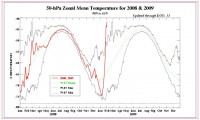
Larger imager here.
As cold expanding high pressure expands south into the lower 48 next week, it will suppress the jet stream and its associated still active storm track well south resulting in a MEMORABLE wintry weather period that will in the end when taken together with the cold in December and January have this winter remembered as an old-fashioned 1960s like winter. Many places deep into the south and east will see heavy snow and ice while unseasonably cold air dominates across the north.
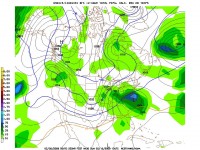
Larger imager here.
In the end the CPC winter forecast from October 16 based mainly on decadal trends (thought to represent global warming) will be a decided bust. Like the stock market, technical traders will tell you, trends can take you only so far. They invariably reverse.
More cold will occur in the UK and all Europe the next few weeks, where the warm winter forecast by the UKMO also never materialized. Very heavy snows will fall in the mountains where it has been a very snowy winter. Even the forecasters in the UK have noted some similarity to the 1960s and mentioned the early 1800s. Surprisingly that is what the low solar (sun still spotless like a Florida orange which ironically Thursday was caked in ice with temperatures down into the 20s -23 in Palmdale) suggests - a return to the early 1800s Dalton like minimum weather.
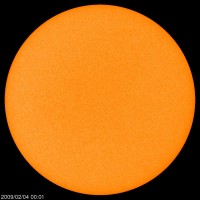
Larger imager here.
In the end the CPC winter forecast from October 16 based mainly on decadal trends (thought to represent global warming) will be a decided bust. Like the stock market, technical traders will tell you, trends can take you only so far. They invariably reverse.

Larger imager here.
The last four cycles were very similar to late 1700s prior to the Dalton Minimum, which makes sense given the phasing of the 106 and 212 year minima the next few decades (Clilverd et al 2006 forecast shown).
Should Alaska’s Mt. Redoubt blow big soon, that would translate into a cooler than normal summer and another cold winter next year with more blocking like we see upcoming even if a weak El Nino developed. El Ninos do occur in cold PDO phases but are weaker and briefer thus usually colder. Than again if the sun stays quiet, La Nina may not disappear. La Ninas dominate at solar minima. See PDF here.
BBC
UPDATE: 02/07/09 Snow conditions continuing in UK with more to come.
UPDATE: 02/06/09: Snow reached all the way down to Morocco in North Africa where six brothers and sisters have died when their house fell down following heavy snowfalls, state media says.
In the UK, drivers had to contend with heavy snowfall on their way to work. Heavy snow has brought a fifth day of chaos to the UK, with severe weather warnings issued to much of the country. Road, rail and air transport is again badly affected, while hundreds of schools have again been closed. See video of the chaos from the BBC here. And this video of many drivers abandoning their cars on the side of the road near Exeter, as the weather worsened on Thursday night.
The West Country and south Wales were worst-hit, with Okehampton in west Devon seeing 22in (55cm) of snow. The Severn Crossings have been closed after ice began falling onto cars and smashing windscreens, while about 200 people were rescued from cars in Devon.
Five windscreens were smashed on the second Severn Crossing - the M4 - on Friday morning, the Highways Agency said. Jim Clune, general manager of Severn River Crossing PLC, said sheets of ice measuring up to a square metre had fallen from overhead sign gantries.
Drifting snow could make the roads more difficult to clear in parts of the West Country. “It’s very much a safety hazard and, of course, these gantries span all carriageways on the motorways.” Heavy snow, some of it a foot (30cm) deep, has cut off some villages in Devon and Somerset and snow is still falling.
The bad weather left 21,000 homes across the West Country without power on Friday. Western Power Distribution (WPD) said 12,000 residents in Devon were without electricity. Another 8,000 homes in the Taunton area were also without power. “We have everyone available working on this. We hope to restore power to as many people as we can today,” a WPD spokeswoman said.

Thousands of callouts
A young couple are recovering after being stuck for 12 hours in an upturned car which was stuck in a ditch near Camelford in Cornwall. Police spent six hours searching for the pair, aided by a Royal Navy helicopter and Cornwall Search and Rescue volunteers. The AA had received more than 3,000 callouts by 0930 GMT on Friday, double its normal workload, and it warned that shortages of road salt had created a “road safety crisis”. Emergency services had spent Thursday night rescuing stranded motorists from the A38 at Haldon Hill, near Exeter, after the weather deteriorated suddenly. A few miles west, the Army was called in to pick up about 60 people stuck on the A386. Many drivers spent the night in emergency centres.
The Met Office warned that heavy snow was likely on high ground in Bath, Bristol, Devon, Dorset, Gloucestershire, Somerset, Plymouth, Swindon, Torbay and Wiltshire. Read more here. See UK alarmist, I mean stoat go bezerk with snow here.
By Richard Alleyne, Science Correspondent, UK Telegraph
Britain may be in the grip of the coldest winter for 30 years and grappling with up to a foot of snow in some places but the extreme weather is entirely consistent with global warming, claim scientists. (Icecap comment: “so keep the grant money coming please")
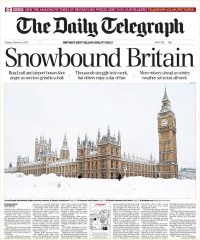
Temperatures for December and January were consistently 1.8 F ( 1 C) lower than the average of 41 F (5 C)and 37 F (3C) respectively and more snow fell in London this week than since the 1960s.
But despite this extreme weather, scientists say that the current cold snap does not mean that climate change is going into reverse. In fact, the surprise with which we have greeted the extreme conditions only reinforces how our climate has changed over the years.
A study by the Met Office which went back 350 years shows that such extreme weather now only occurs every 20 years. Back in the pre-industrial days of Charles Dickens, it was a much more regular occurrence - hitting the country on average every five years or so. During that time global temperatures has risen by 1.7 F (0.8 C), studies have shown.
“Even though this is quite a cold winter by recent standards it is still perfectly consistent with predictions for global warming,” said Dr Myles Allen, head of the Climate Dynamics group at Department of Physics, University of Oxford. “If it wasn’t for global warming this cold snap would happen much more regularly. What is interesting is that we are now surprised by this kind of weather. I doubt we would have been in the 1950s because it was much more common.
“As for snowfall that could actually increase in the short term because of global warming. We have all heard the expression ‘too cold to snow’ and we have always expected precipitation to increase. “All the indicators still suggest that we are warming up in line with predictions.”
This winter seems so bad precisely because it is now so unusual. In contrast the deep freezes of 1946-47 and 1962-63 were much colder - 5.3 F (2.97C) and 7.9 F (4.37C) cooler than the long-term norm. And with global warming we can expect another 1962-63 winter only once every 1,100 years, compared with every 183 years before 1850.
Dave Britton, a meteorologist and climate scientist at the Met Office, said: “Even with global warming you cannot rule out we will have a cold winter every so often. It sometimes rains in the Sahara but it is still a desert.”
Scientists point out that the people must distinguish between climate and weather. Weather is what happens in the short term whereas climate is the long term trend. “Just as the wet summer of 2007 or recent heat waves cannot be attributed to global warming nor can this cold snap,” said Bob Ward, spokesman for the Grantham Research Institute for Climate Change at London School of Economics. “What is important to do is look at the long term global trends and they are still up. What we experience in the short term in this country is not important. After all, Melbourne had a heat wave last week.”
Read more here. See how Britons were angered by the government’s inability to deal with the storm which may have a cost topping $4.3 billion here.
Sorry guys, the jig is up. Yes weather is different from climate but a climate regime change has taken place which will mean this kind of weather will happen more frequently. Your excuses and claims will seem more and more ludicrous with each passing storm or cold day/season. Better either open you minds or start looking for another line of work.
See another on point essay on “Climate Alarmists: Having it both ways!” by Bob Webster here.
By Dr. Tim Ball, Canada Free Press
The full proverb says, “Give a dog a bad name and hang him.” They’ve given carbon dioxide (CO2) a bad name and it is now being hanged by draconian and completely unnecessary legislation. Consider this comment by Susan Solomon, NOAA senior scientist, “I think you have to think about this stuff (CO2) as more like nuclear waste than acid rain: The more we add, the worse off we’ll be,” An alarmist, outrageous and completely unsupportable comment, but not surprising from the co-chair of Working Group I of the IPCC 2007 report.
The reality is if CO2 is reduced we are worse off as the plants suffer. Something must be done to protect the plants from fanaticism.
There is no evidence CO2 is causing global warming or climate change but that is the basis for the slur and the proposed actions. As usual little thought is given to the direct and collateral damage such as the economic impacts from increased taxes and cost of doing business. No thought is given to the damage to nature. So you have the paradox of environmentalists screaming to reduce CO2 to save the planet, while putting all life in jeopardy by killing the plants. It is blind faith. But this is not surprising because the great problem of environmentalism as a religion is the failure to do full and proper cost/benefit analyses. For example, all you ever hear about are the down sides to warming when there are actually more up sides. One major downside rarely mentioned is the impact on plants of reduced CO2 levels.
Extreme environmentalists consider plants and animals more important than humans. Ron Arnold, Executive Vice-President of the Center for the Defense of Free Enterprise, said, “Environmentalism intends to transform government, economy, and society in order to liberate nature from human exploitation”
David Graber, a research biologist with the National Park Service said, “Human happiness, and certainly human fecundity, are not as important as a wild and healthy planet.” “Until such time as Homo Sapiens should decide to rejoin nature, some of us can only hope for the right virus to come along.”
Getting rid of everyone permanently solves the problem - David Foreman former chief lobbyist for the Wilderness Society says the optimum number is zero. Ingrid Newkirk of People for the Ethical Treatment of Animals said, “Mankind is a cancer; we’re the biggest blight on the face of the earth.” “If you haven’t given voluntary human extinction much thought before, the idea of a world with no people in it may seem strange. But, if you give it a chance, I think you might agree that the extinction of Homo Sapiens would mean survival for millions if not billions, of Earth-dwelling species, Phasing out the human race will solve every problem on earth, social and environmental.”
In a dramatic twist the virus Graber awaits and the reduction to zero may be the campaign of environmentalists, both moderate and extreme, to reduce CO2. It is a fascinating and perverse unintended consequence. All climate policy is designed to reduce atmospheric CO2, but that is not what the plants would vote for. Plant producers have added CO2 to enclosed growing environments for 100 years to enhance growth. Extensive research shows the beneficial effects including a significant increase in biomass including roots, size of the plant and yields. Another benefit is a reduction in the amount of water used. As CO2 levels increase the stomata (pores on the leaf) partially close thus moisture loss (transpiration) is reduced.
The current atmospheric CO2 level is reportedly 380 ppm. Plant growth slows at 220 ppm and stops at 150 ppm. Most plants grow 2 to 3 times faster in 1200 to 1500 ppm, but the optimum range is 800 to 1000 ppm. This means plants are malnourished under current conditions. Environmentalists and governments have abandoned the plants in the false belief a reduction of CO2 would stop global warming. It is time to defend the plants from these misguided people. The obvious solution is to seek power of attorney for the plants to vote on their behalf against any attempts to reduce atmospheric CO2. This way we can satisfy another old proverb and stop them being killed by kindness.
See post here.
See NASA satellite determined greening of middle latitudes in recent decades due to increased CO2 and slightly warmer temperatures below.
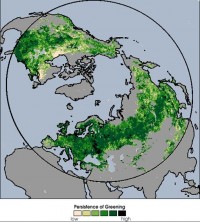
Chicago ended January with a monthly average of 15.8, 6.2F below normal, which made it the 10th coldest in 137 years. The coldest last month was -18F on the 16th.
Jan Average(F)
1977 10.1
1912 11.9
1893 12.1
1982 12.2
1979 12.4
1963 13.3
1918 13.3
1985 14.4
1888 14.9
2009 15.8
1994 15.9
1978 15.9
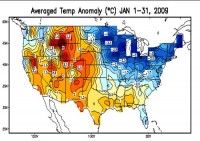
Larger map here.
Chicago was not alone, with most areas of the central and northeast well below normal. See for example Marquette, MI where it ranked, 7th coldest. In Boston, January averaged 4.5 degrees below normal with no January thaw. Just two days touched 40F.
In December, Chicago averaged 22.9F, 4.5 colder than normal and the 18th coldest in 137 years.
Dec Average (F)
1983 14.3
2000 16.0
1985 17.0
1989 17.4
1963 17.9
1872 18.4
1876 19.4
1950 19.6
1976 20.0
1903 20.1
1919 21.4
1909 21.7
1944 22.0
1945 22.2
1958 22.4
1917 22.5
2008 22.9
For the December to January period, it ranked 10 coldest in 139 years.
Dec/Jan Average (F)
1976/77 15.05
1983/84 15.70
1892/93 17.80
1917/18 17.90
1981/82 18.55
1903/04 18.90
1872/73 19.00
1962/63 19.15
1978/79 19.25
2008/09 19.35
1985/86 19.90
1919/20 20.10
1977/78 20.30
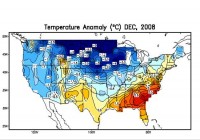
Larger map here.
See PDF here with December and January rankings. It should be noted Chicago was not ground zero, It was colder to the north and west, but Chicago data was more readily available and generally representative of the cold central. See this about eastern Michigan where it was a top ten coldest Januarys. This is from western Michigan. This is from southern Wisconsin.
Here was the October 16th, 2008 CPC forecast for November, December and January based mainly on trends (NCDC engineered global warming).
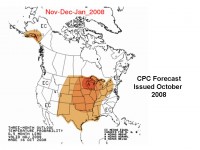
Larger map here.
How is global warming doing as a forecast tool?
By the way after a cold few days and a week or roller coast temperatures, an extremely interesting last half of February appears to be in the cards with widespread cold and a suppresed jet stream, massive polar high pressure across the north entrenched in Canada and an active southern storm track along the boundary.
Space Daily
Czech President Vaclav Klaus took aim at climate change campaigner Al Gore on Saturday in Davos in a frontal attack on the science of global warming.
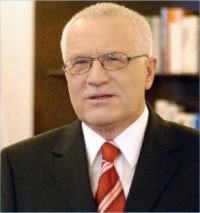
“I don’t think that there is any global warming,” said the 67-year-old liberal, whose country holds the rotating presidency of the European Union. “I don’t see the statistical data for that.”
Referring to the former US vice president, who attended Davos this year, he added: “I’m very sorry that some people like Al Gore are not ready to listen to the competing theories. I do listen to them.
“Environmentalism and the global warming alarmism is challenging our freedom. Al Gore is an important person in this movement.”
Speaking on the sidelines of the World Economic Forum, he said that he was more worried about the reaction to the perceived dangers than the consequences.
“I’m afraid that the current crisis will be misused for radically constraining the functioning of the markets and market economy all around the world,” he said. “I’m more afraid of the consequences of the crisis than the crisis itself."Klaus makes no secret of his climate change scepticism—he is also a fierce critic of the European Union—and has branded the world’s top panel of climate experts, the UN’s IPCC, a smug monopoly.All rights reserved.
Read more here.
Vaclav Klaus will be one of the keynote speakers at the upcoming Heartland ICCC Conference in New York City, March 8-10. Last year’s address was indeed inspiring. We look forward to his reprise this year. It is not too late to join the world’s finest scientists, economists and policy experts (1000 are expected) for a once in a lifetime experience.
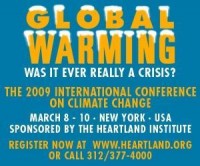
By Dan Joling, AP News, January 30, 2008
Hardware stores and auto parts shops scored a post-holiday run of business this week as Anchorage-area residents stocked up on protective eyewear and
masks ahead of a possible eruption of Mount Redoubt. Monitoring earthquakes underneath the 10,200-foot Redoubt Volcano about 100 miles southwest of Anchorage, scientists from the Alaska Volcano Observatory warned that an eruption was imminent.
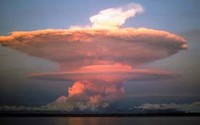
Mt Redoubt when it last erupted in 1989. See a larger image here.
Peter Cervelli, a research geophysicist with the observatory, told CNN that “every indication is that we’re heading toward an eruption.” The predictions are sending experienced Alaskans shopping for protection against a dusty shower of volcanic ash that could descend on south-central Alaska. “Every time this happens we do get a run on dust masks and goggles,” said Phil Robinson, manager of an Alaska Industrial Hardware store in Anchorage. “That’s the two main things for eye and respiratory protection.”
Customer Ron Cowan picked up gear at the store Thursday before heading off to an auto parts store for a spare air filter. “I’m older now and I’m being a little more proactive than I was the last time,” Cowan said. When another Alaska volcano, Mount Spurr, blew in 1992, he waited too long. “The shelves were cleared, so I thought I wouldn’t wait until the last minute,” Cowan said.
Unlike earthquakes, volcanoes often give off warning signs that usually give people time to prepare. The observatory, a joint program between the U.S. Geological Survey, the University of Alaska Geophysical Institute and the state Division of Geological and Geophysical Surveys, was formed in response to the 1986 eruption of Mount Augustine. Read more here.
What effect might that eruption have? Well if it does blow and extends 35-45,000 feet or more up into the more stable high atmosphere of the polar regions it would have some climatic effects with cooling starting this summer. Robock (2003) and others have shown that though major volcanic eruptions seem to have their greatest cooling effect in the summer months, the location of the volcano determines whether the winters are colder or warmer over large parts of North America and Eurasia.
According to Robock, tropical region volcanoes like El Chichon and Pinatubo actually produce a warming in winter due to a tendency for a more positive North Atlantic Oscillation (NAO) and Arctic Oscillation (AO) (below left). In the positive phase of these large scale pressure oscillations, low pressure and cold air is trapped in high latitudes and the resulting more westerly jet stream winds drives milder maritime air into the continents.
Robock however found high latitude volcanoes like Katmai (Alaska in 1912,) instead favored the negative phase of the Arctic and North Atlantic Oscillations and cold winters (below right). In the negative phase, the jet stream winds buckled and forced cold air south from Canada into the eastern United States and west from Siberia into Europe. Despite the regional differences in winter, globally on an annual basis, volcanic eruptions lead to a net cooling regardless as to the volcano’s latitude.
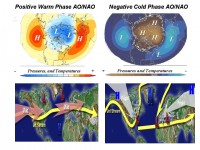
See larger image here.
Read more on volcanos and climate here.
See update this morning (February 2) from Live Science ”What’s Happening Beneath Mt. Redoubt”. Mount Redoubt volcano in Alaska could erupt within days to weeks, say scientists at the U.S. Geological Survey, amazing the rest of us with their certainty.
Here’s what makes them so sure: Magma rising toward the surface from beneath a volcano like Redoubt can cause earthquakes and other seismic rumblings. And seismic activity at Redoubt, which is 106 miles (170 km) southwest of Anchorage, has increased recently.
“If you’re going to bring magma to the surface you’ve got to break rock, and every time rocks break at the subsurface beneath a volcano, that’s an earthquake,” said volcanologist Charles Mandeville of the American Museum of Natural History in New York. “They’re recording a whole bunch of earthquakes almost continuously right now,” he said, referring to scientists at the Alaska Volcano Observatory in Anchorage.
AMS Science Group Erred Giving Hansen Top Honor’
By environmental journalist Andrew Freeman, the Washington Post Weather Gang
Why AMS was mistaken in granting him its top honor… By honoring Hansen, the AMS has raised questions about the proper role of scientists in a world that is facing complex challenges that mix science and politics. A key issue is whether it is appropriate for prominent scientists to serve dual roles as researchers and advocates for political change, or if must there be a clear separation between the two.
In Hansen’s case, the line between science and politics has been blurry, as I discussed in a column last summer. In bestowing the Rossby medal upon Hansen, the AMS cited his “outstanding contributions to climate modeling, understanding climate change forcings and sensitivity, and for clear communication of climate science in the public arena.” But his tactics and tone have sharpened considerably as policy makers have moved slowly (much too slowly, in his view and the view of many others) to enact emissions curbs. Last year, for example, Hansen testified in a British court in support of six Greenpeace climate activists who were on trial after they scaled a smokestack at a coal-fired power plant and painted the name “Gordon” down the stack (in reference to the U.K. Prime Minister, Gordon Brown). The activists were cleared of charges in September. Hansen has called for a global freeze of coal fired power plant construction due to the associated carbon dioxide emissions, and issued a public letter [pdf] to the Obama administration containing his scientific views and policy recommendations. Further examples of his politically-oriented work can be found on his Columbia University web site.

Some AMS members have taken issue with Hansen’s outspokenness and political advocacy on climate change, and the reaction from some meteorologists has been harsh. Meteorologist Joe D’Aleo was quoted on the New York Times’ Dot Earth blog as saying that the AMS’ decision to honor Hansen was “a sad day and embarrassment for a once great society that has lost its way.” D’Aleo, like many meteorologists who specialize in day-to-day weather rather than long-term climate trends, is skeptical that human activities are causing climate change, and indeed has disputed whether the climate is warming at all. However out of step he may be with mainstream climate science, he represents a significant constituency of the AMS.
Hansen’s vocal support for steep greenhouse gas emissions cuts and a ban on coal-fired power plants has caused some critics to dismiss his scientific findings as biased in favor of his political goals. Such sentiment was expressed by Craig James, an AMS member and retired television meteorologist who discussed his views on the “Icecap” blog. “I believe Dr. Hansen’s political ideology has taken over his science and renders him no longer qualified to be the keeper of the global temperature data,” James said.
Such advocacy, which is Hansen’s right as a citizen, threatens to paint the AMS as having a political agenda too. The AMS would be wise to publicly set the record straight on where it stands regarding the separation between a scientist and a political advocate, and how that relates to Hansen’s award.
Read more here.
By Henk Tennekes on Climate Science
Roger Pielke Sr. has graciously invited me to add my perspective to his discussion with Gavin Schmidt at RealClimate. If this were not such a serious matter, I would have been amused by Gavin’s lack of knowledge of the differences between weather models and climate models. As it stands, I am appalled. Back to graduate school, Gavin!
A weather model deals with the atmosphere. Slow processes in the oceans, the biosphere, and human activities can be ignored or crudely parameterized. This strategy has been very successful. The dominant fraternity in the meteorological modeling community has appropriated this advantage, and made itself the lead community for climate modeling. Backed by an observational system much more advanced than those in oceanography or other parts of the climate system, they have exploited their lead position for all they can. For them, it is a fortunate coincidence that the dominant synoptic systems in the atmosphere have scales on the order of many hundreds of kilometers, so that the shortcomings of the parameterizations and the observation network, including weather satellite coverage, do not prevent skillful predictions several days ahead.
A climate model, however, has to deal with the entire climate system, which does include the world’s oceans. The oceans constitute a crucial slow component of the climate system. Crucial, because this is where most of the accessible heat in the system is stored. Meteorologists tend to forget that just a few meters of water contain as much heat as the entire atmosphere. Also, the oceans are the main source of the water vapor that makes atmospheric dynamics on our planet both interesting and exceedingly complicated. For these and other reasons, an explicit representation of the oceans should be the core of any self-respecting climate model.
However, the observational systems for the oceans are primitive in comparison with their atmospheric counterparts. Satellites that can keep track of what happens below the surface of the ocean have limited spatial and temporalresolution. Also, the scale of synoptic motions in the ocean is much smaller than that of cyclones in the atmosphere, requiring a spatial resolution in numerical models and in the observation network beyond the capabilities of present observational systems and supercomputers. We cannot observe, for example, the vertical and horizontal structure of temperature, salinity and motion of eddies in the Gulf Stream in real time with sufficient detail, and cannot model them at the detail that is needed because of computer limitations. How, for goodness’ sake, can we then reliably compute their contribution to multi-decadal changes in the meridional transport of heat? Are the crude parameterizations used in practice up to the task of skillfully predicting the physical processes in the ocean several tens of years ahead? I submit they are not.
Since heat storage and heat transport in the oceans are crucial to the dynamics of the climate system, yet cannot be properly observed or modeled, one has to admit that claims about the predictive performance of climate models are built on quicksand. Climate modelers claiming predictive skill decades into the future operate in a fantasy world, where they have to fiddle with the numerous knobs of the parameterizations to produce results that have some semblance of veracity. Firm footing? Forget it!
Gavin Schmidt is not the only meteorologist with an inadequate grasp of the role of the oceans in the climate system. In my weblog of June 24, 2008, I addressed the limited perception that at least one other climate modeler appears to have. A few lines from that essay deserve repeating here. In response to a paper by Tim Palmer of ECMWF, I wrote: “Palmer et al. seem to forget that, though weather forecasting is focused on the rapid succession of atmospheric events, climate forecasting has to focus on the slow evolution of the circulation in the world ocean and slow changes in land use and natural vegetation. In the evolution of the Slow Manifold (to borrow a term coined by Ed Lorenz) the atmosphere acts primarily as stochastic high-frequency noise. If I were still young, I would attempt to build a conceptual climate model based on a deterministic representation of the world ocean and a stochastic representation of synoptic activity in the atmosphere.”
From my perspective it is not a little bit alarming that the current generation of climate models cannot simulate such fundamental phenomena as the Pacific Decadal Oscillation. I will not trust any climate model until and unless it can accurately represent the PDO and other slow features of the world ocean circulation. Even then, I would remain skeptical about the potential predictive skill of such a model many tens of years into the future. See post here.
Read three essays by Tennekes here.




